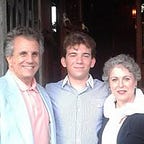How to Have Cascading Impact
If we want to solve the “big” problems (climate, poverty, pandemics, etc.), we need to solve some “smaller” problems first. By getting a handle on these smaller problems, we position ourselves to attack something bigger.
I am in process of finding some smaller problems I care about and want to work on. The criteria are:
- Small enough and relevant to my skills that I can have an impact,
- Big enough to matter, and connected to the larger problems I care about.
I’ve long been concerned that, while there are many problems that check one of these boxes, I’ve yet to find one that checks both. However, I’m starting to realize that some of the problems I used to put only in box (1), may actually belong in box (2) as well, if I change my perspective.
Making this shift requires a slightly more nuanced theory of change (see more on theories of change here). For example, in Juan Benet’s recent talk at DevConnect CryptoEcon Day, he outlines the following strategy for attacking climate change:
1. Make Filecoin green.
2. Show (1) as a case study of how the rest of the blockchain industry can be green (and induce peer pressure on others to do so — PR competition of who can be the greenest).
3. Once the blockchain industry is green, pressure for the rest of Tech to be green.
4. Once Tech is green, peer-pressure for other industries to be green.
He emphasizes that, rather than trying to take the entire problem at once (e.g. climate change) and making only incremental progress, it’s important to start with a smaller problem where you can have a real transformational effect. He’s designed a path that starts small but can get big.
It’s having the map of these cascading effects that I’ve lacked. Without that, the “small” problems seem approachable, but not big enough to matter.
Another map I’ve considered is the following:
1. Fix social media: tools for better discourse, collectively-owned and effectively-governed online communities
2. By fixing social media, we build a stronger foundation for healthy public discourse in general [1].
3. With healthier public discourse, we can engage in productive political conversation.
4. With productive political conversation, we can make good collective decisions and public policy.
5. With better public policy, we can solve our largest challenges.
I’m getting inspired by the idea that we all need some map like this to decide how we want to have impact on the world. I’m curious to see more examples of such maps: what end-goal we’re trying to enable, where we want to start, and what sequence of cascading effects we hope to kick off.
I’d like a rigorous way to understand these cascades. We have to think of civilization as a complex system we’re trying to shape, where a small change to the inputs can cause a large change in outcomes, by pushing the system past some tipping point. How do we find chains of tipping points, where small ones lead to progressively larger ones? How do we evaluate which cascades are likely to work, and which ones will likely get stuck?
The study of nucleation and percolation theory seems relevant — understanding what conditions lead to a phase transition in a system, and over what time- and spatial-scales such transitions happen. These have been studied extensively in physics, mostly for relatively simple systems — but we are only just beginning to lay out a framework for applying these techniques to more complex, social/civilizational systems. I wonder if there’s a way to sidestep the really difficult science problems here, and get a good intuition for how to identify high-impact cascades vs. low-impact ones.
[1] This is because much of our interaction with each other is in some way mediated online. Especially when we no longer interact with one another in physical “third spaces” (i.e. non-home, non-work spaces — churches, town squares, sporting events, etc.) nearly as much as we used to, the online environment has become the replacement.
